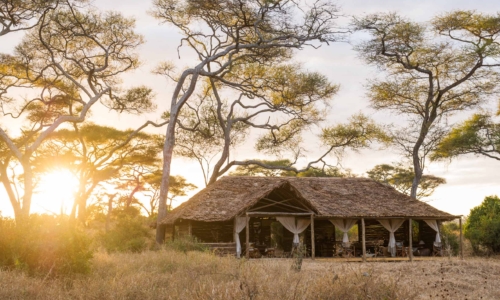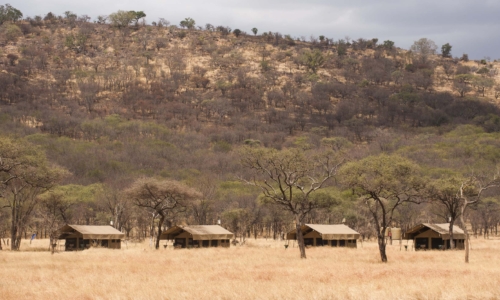Tarangire is the sixth largest national park in Tanzania and occupies 1,100 square miles to the southwest of Arusha. A place of widely diverse landscape and vegetation, it encompasses hills dotted with fascinating baobab trees, dense bush, granite ridges, river valleys, swamps, and high grasses. This varied landscape is also famous for the termite mounds that dot the landscape. The Tarangire River bisects the park and is the primary source of fresh water for wild animals during the annual dry season. As large Park, it is usually overlooked for the more popular Serengeti and is therefore less crowded. However, the ecosystem here is balanced by a localized migration pattern resulting in varied amounts of game-viewing outside of the dry season between June and October.
The Park sees the greatest concentration of wildlife outside the Serengeti ecosystem, and this is the only place in Tanzania where dry-country antelope such as the stately fringe-eared oryx and peculiar long-necked gerenuk are regularly observed. Best known for its impressive elephant population, Tarangire is home to large herds totaling nearly 2,500 individuals. It’s also known for its tree-climbing lions and there are also African pythons up in the boughs too. Plains game like migratory wildebeest, zebra, buffalo, impala, gazelle, hartebeest, and eland crowd the shrinking lagoons. Predators such as hyena, wild dog, leopard, and cheetah are not far behind.
For birding enthusiasts, it is the green tinged swamps that beckon the approximately 550 bird species to the area in breeding pairs. On drier ground, regular sightings of Kori-bustard, strutting black plumed male and drab grey female ostrich, and smaller groups of turkey-like ground hornbills are found. Then there are the screeching flocks of the dazzling yellow-collared lovebird and pairs of red-and-yellow barbet as well as the rufous-tailed weaver and ashy starling. All are endemic to the dry savanna of north-central Tanzania.
There are plenty of activities to enjoy in the park. The local safari camps and lodges offer daily games drives led by expert guides in comfortable 4×4 vehicles. Bush walks with an armed guard explore the landscape in greater detail and examine the smaller flora and fauna. Fly camping is the ultimate adventure as the animals wander outside and a blanket of stars covers the night sky. There are also cultural visits to local Maasai villages to learn about these mighty warriors and cattle farmers and their rich traditions. Other excursions take visitors to see the hundreds of ancient rock paintings in the vicinity of Kolo on the Dodoma Road.


- Bashay Rift Lodge
- Beho Beho Camp
- Chada Katavi
- Chaka Camp
- Chem Chem Lodge
- Dunia Camp
- Entamanu Ngorongoro
- Entamanu Private
- Esirai Camp
- Ewanjan Tented Camp
- Faru Faru Lodge
- Forest Chem Chem
- Fumba Beach Lodge
- Fundu Lagoon
- Gibb’s Farm
- Greystoke Mahale
- Grumeti Hills
- Grumeti Serengeti River Lodge
- Ikuka Safari Camp
- Jabali Ridge
- Jongomero
- Kaskaz Mara Camp
- Kiba Point Selous
- Kichaka
- Kichakani Serengeti Camp
- Kichuguu Camp
- Kigelia Ruaha
- Kilima
- Kiota Camp
- Kisima Ngeda Camp
- Kitela Lodge
- Klein’s Camp
- Kokoko Camp
- Kuria Hills Lodge
- Kuro Tarangire
- Kusini Kopjes Kambi
- Kusini Serengeti
- Kwihala Camp
- Lake Manyara Tree Lodge
- Lamai Serengeti
- Little Chem Chem
- Little Oliver’s Camp
- Manyara Ranch Conservancy
- Mara River Post
- Mara River Tented Camp
- Mara Tented Camp
- Maweninga Camp
- Melia Ngorongoro
- Mila Tented Camp
- Milele
- Mkombe’s House
- Mnemba Island
- Mpingo Ridge Lodge
- Mwiba Lodge
- Namiri Plains
- Naona Moru Camp
- Nasikia Mobile Camp
- Ndutu Safari Lodge
- Ndutu Tented Camp
- Ngorongoro Crater Camp
- Ngorongoro Crater Lodge
- Ngorongoro Serena Safari Lodge
- Ngorongoro Sopa Lodge
- Ngorongoro Tented Camp
- Nomad Expeditionary Walking Camp
- Nyasi Tented Camp
- Olaado Camp
- Olakira Migration Camp
- Olduvai Camp
- Olduvai Ndogo
- Oliver’s Camp
- Olkeri Camp
- Olmara Camp
- Roho ya Selous
- Ronjo Camp
- Rubondo Island Camp
- Sabora Tented Camp
- Sanctuary Serengeti Migration Camp
- Sand Rivers Selous
- Sasakwa Lodge
- Sayari Camp
- Selous Serena Camp
- Serena Mivumo River Lodge
- Serengeti Bushtops
- Serengeti House
- Serengeti Kati Kati Tented Camp
- Serengeti Migration Camp
- Serengeti Pioneer Camp
- Serengeti Safari Camp
- Serengeti Under Canvas
- Serian’s Serengeti
- Serian’s Serengeti Mobile
- Singita Explore
- Singita Kilima
- Siwandu
- Songa Migrational Camp
- Swala
- Taasa Lodge
- Tarangire Ndovu Tented Lodge
- Tarangire Safari Lodge
- Tarangire Sopa Lodge
- Tarangire Treetops
- The Highlands
- The Manor at Ngorongoro
- Ubuntu Migration Camp
- Usangu Expedition Camp
- Usawa Serengeti
- Arumeru Lodge
- Arusha Coffee Lodge
- Baraza Resort & Spa
- Breezes Beach Club & Spa
- Chole Mjini
- Dar es Salaam Serena Hotel
- Fanjove Island
- Hamerkop House
- Katambuga House
- Kilindi Zanzibar
- Lake Duluti Lodge
- Legendary Lodge
- Matemwe Beach House
- Matemwe Lodge
- Matemwe Retreat
- Ngare Sero Mountain Lodge
- Oyster Bay Hotel
- Plantation Lodge
- Rivertrees Country Inn
- The Palms
- Zanzibar Serena Hotel
- Zawadi Hotel
- Zuri Zanzibar
Coming soon!
- Bashay Rift Lodge
- Beho Beho Camp
- Chada Katavi
- Chaka Camp
- Chem Chem Lodge
- Dunia Camp
- Entamanu Ngorongoro
- Entamanu Private
- Esirai Camp
- Ewanjan Tented Camp
- Faru Faru Lodge
- Forest Chem Chem
- Fumba Beach Lodge
- Fundu Lagoon
- Gibb’s Farm
- Greystoke Mahale
- Grumeti Hills
- Grumeti Serengeti River Lodge
- Ikuka Safari Camp
- Jabali Ridge
- Jongomero
- Kaskaz Mara Camp
- Kiba Point Selous
- Kichaka
- Kichakani Serengeti Camp
- Kichuguu Camp
- Kigelia Ruaha
- Kilima
- Kiota Camp
- Kisima Ngeda Camp
- Kitela Lodge
- Klein’s Camp
- Kokoko Camp
- Kuria Hills Lodge
- Kuro Tarangire
- Kusini Kopjes Kambi
- Kusini Serengeti
- Kwihala Camp
- Lake Manyara Tree Lodge
- Lamai Serengeti
- Little Chem Chem
- Little Oliver’s Camp
- Manyara Ranch Conservancy
- Mara River Post
- Mara River Tented Camp
- Mara Tented Camp
- Maweninga Camp
- Melia Ngorongoro
- Mila Tented Camp
- Milele
- Mkombe’s House
- Mnemba Island
- Mpingo Ridge Lodge
- Mwiba Lodge
- Namiri Plains
- Naona Moru Camp
- Nasikia Mobile Camp
- Ndutu Safari Lodge
- Ndutu Tented Camp
- Ngorongoro Crater Camp
- Ngorongoro Crater Lodge
- Ngorongoro Serena Safari Lodge
- Ngorongoro Sopa Lodge
- Ngorongoro Tented Camp
- Nomad Expeditionary Walking Camp
- Nyasi Tented Camp
- Olaado Camp
- Olakira Migration Camp
- Olduvai Camp
- Olduvai Ndogo
- Oliver’s Camp
- Olkeri Camp
- Olmara Camp
- Roho ya Selous
- Ronjo Camp
- Rubondo Island Camp
- Sabora Tented Camp
- Sanctuary Serengeti Migration Camp
- Sand Rivers Selous
- Sasakwa Lodge
- Sayari Camp
- Selous Serena Camp
- Serena Mivumo River Lodge
- Serengeti Bushtops
- Serengeti House
- Serengeti Kati Kati Tented Camp
- Serengeti Migration Camp
- Serengeti Pioneer Camp
- Serengeti Safari Camp
- Serengeti Under Canvas
- Serian’s Serengeti
- Serian’s Serengeti Mobile
- Singita Explore
- Singita Kilima
- Siwandu
- Songa Migrational Camp
- Swala
- Taasa Lodge
- Tarangire Ndovu Tented Lodge
- Tarangire Safari Lodge
- Tarangire Sopa Lodge
- Tarangire Treetops
- The Highlands
- The Manor at Ngorongoro
- Ubuntu Migration Camp
- Usangu Expedition Camp
- Usawa Serengeti
- Arumeru Lodge
- Arusha Coffee Lodge
- Baraza Resort & Spa
- Breezes Beach Club & Spa
- Chole Mjini
- Dar es Salaam Serena Hotel
- Fanjove Island
- Hamerkop House
- Katambuga House
- Kilindi Zanzibar
- Lake Duluti Lodge
- Legendary Lodge
- Matemwe Beach House
- Matemwe Lodge
- Matemwe Retreat
- Ngare Sero Mountain Lodge
- Oyster Bay Hotel
- Plantation Lodge
- Rivertrees Country Inn
- The Palms
- Zanzibar Serena Hotel
- Zawadi Hotel
- Zuri Zanzibar
Coming soon!

Tarangire is the sixth largest national park in Tanzania and occupies 1,100 square miles to the southwest of Arusha. A place of widely diverse landscape and vegetation, it encompasses hills dotted with fascinating baobab trees, dense bush, granite ridges, river valleys, swamps, and high grasses. This varied landscape is also famous for the termite mounds that dot the landscape. The Tarangire River bisects the park and is the primary source of fresh water for wild animals during the annual dry season. As large Park, it is usually overlooked for the more popular Serengeti and is therefore less crowded. However, the ecosystem here is balanced by a localized migration pattern resulting in varied amounts of game-viewing outside of the dry season between June and October.
The Park sees the greatest concentration of wildlife outside the Serengeti ecosystem, and this is the only place in Tanzania where dry-country antelope such as the stately fringe-eared oryx and peculiar long-necked gerenuk are regularly observed. Best known for its impressive elephant population, Tarangire is home to large herds totaling nearly 2,500 individuals. It’s also known for its tree-climbing lions and there are also African pythons up in the boughs too. Plains game like migratory wildebeest, zebra, buffalo, impala, gazelle, hartebeest, and eland crowd the shrinking lagoons. Predators such as hyena, wild dog, leopard, and cheetah are not far behind.
For birding enthusiasts, it is the green tinged swamps that beckon the approximately 550 bird species to the area in breeding pairs. On drier ground, regular sightings of Kori-bustard, strutting black plumed male and drab grey female ostrich, and smaller groups of turkey-like ground hornbills are found. Then there are the screeching flocks of the dazzling yellow-collared lovebird and pairs of red-and-yellow barbet as well as the rufous-tailed weaver and ashy starling. All are endemic to the dry savanna of north-central Tanzania.
There are plenty of activities to enjoy in the park. The local safari camps and lodges offer daily games drives led by expert guides in comfortable 4×4 vehicles. Bush walks with an armed guard explore the landscape in greater detail and examine the smaller flora and fauna. Fly camping is the ultimate adventure as the animals wander outside and a blanket of stars covers the night sky. There are also cultural visits to local Maasai villages to learn about these mighty warriors and cattle farmers and their rich traditions. Other excursions take visitors to see the hundreds of ancient rock paintings in the vicinity of Kolo on the Dodoma Road.

- Bashay Rift Lodge
- Beho Beho Camp
- Chada Katavi
- Chaka Camp
- Chem Chem Lodge
- Dunia Camp
- Entamanu Ngorongoro
- Entamanu Private
- Esirai Camp
- Ewanjan Tented Camp
- Faru Faru Lodge
- Forest Chem Chem
- Fumba Beach Lodge
- Fundu Lagoon
- Gibb’s Farm
- Greystoke Mahale
- Grumeti Hills
- Grumeti Serengeti River Lodge
- Ikuka Safari Camp
- Jabali Ridge
- Jongomero
- Kaskaz Mara Camp
- Kiba Point Selous
- Kichaka
- Kichakani Serengeti Camp
- Kichuguu Camp
- Kigelia Ruaha
- Kilima
- Kiota Camp
- Kisima Ngeda Camp
- Kitela Lodge
- Klein’s Camp
- Kokoko Camp
- Kuria Hills Lodge
- Kuro Tarangire
- Kusini Kopjes Kambi
- Kusini Serengeti
- Kwihala Camp
- Lake Manyara Tree Lodge
- Lamai Serengeti
- Little Chem Chem
- Little Oliver’s Camp
- Manyara Ranch Conservancy
- Mara River Post
- Mara River Tented Camp
- Mara Tented Camp
- Maweninga Camp
- Melia Ngorongoro
- Mila Tented Camp
- Milele
- Mkombe’s House
- Mnemba Island
- Mpingo Ridge Lodge
- Mwiba Lodge
- Namiri Plains
- Naona Moru Camp
- Nasikia Mobile Camp
- Ndutu Safari Lodge
- Ndutu Tented Camp
- Ngorongoro Crater Camp
- Ngorongoro Crater Lodge
- Ngorongoro Serena Safari Lodge
- Ngorongoro Sopa Lodge
- Ngorongoro Tented Camp
- Nomad Expeditionary Walking Camp
- Nyasi Tented Camp
- Olaado Camp
- Olakira Migration Camp
- Olduvai Camp
- Olduvai Ndogo
- Oliver’s Camp
- Olkeri Camp
- Olmara Camp
- Roho ya Selous
- Ronjo Camp
- Rubondo Island Camp
- Sabora Tented Camp
- Sanctuary Serengeti Migration Camp
- Sand Rivers Selous
- Sasakwa Lodge
- Sayari Camp
- Selous Serena Camp
- Serena Mivumo River Lodge
- Serengeti Bushtops
- Serengeti House
- Serengeti Kati Kati Tented Camp
- Serengeti Migration Camp
- Serengeti Pioneer Camp
- Serengeti Safari Camp
- Serengeti Under Canvas
- Serian’s Serengeti
- Serian’s Serengeti Mobile
- Singita Explore
- Singita Kilima
- Siwandu
- Songa Migrational Camp
- Swala
- Taasa Lodge
- Tarangire Ndovu Tented Lodge
- Tarangire Safari Lodge
- Tarangire Sopa Lodge
- Tarangire Treetops
- The Highlands
- The Manor at Ngorongoro
- Ubuntu Migration Camp
- Usangu Expedition Camp
- Usawa Serengeti
- Arumeru Lodge
- Arusha Coffee Lodge
- Baraza Resort & Spa
- Breezes Beach Club & Spa
- Chole Mjini
- Dar es Salaam Serena Hotel
- Fanjove Island
- Hamerkop House
- Katambuga House
- Kilindi Zanzibar
- Lake Duluti Lodge
- Legendary Lodge
- Matemwe Beach House
- Matemwe Lodge
- Matemwe Retreat
- Ngare Sero Mountain Lodge
- Oyster Bay Hotel
- Plantation Lodge
- Rivertrees Country Inn
- The Palms
- Zanzibar Serena Hotel
- Zawadi Hotel
- Zuri Zanzibar
Coming soon!
- Bashay Rift Lodge
- Beho Beho Camp
- Chada Katavi
- Chaka Camp
- Chem Chem Lodge
- Dunia Camp
- Entamanu Ngorongoro
- Entamanu Private
- Esirai Camp
- Ewanjan Tented Camp
- Faru Faru Lodge
- Forest Chem Chem
- Fumba Beach Lodge
- Fundu Lagoon
- Gibb’s Farm
- Greystoke Mahale
- Grumeti Hills
- Grumeti Serengeti River Lodge
- Ikuka Safari Camp
- Jabali Ridge
- Jongomero
- Kaskaz Mara Camp
- Kiba Point Selous
- Kichaka
- Kichakani Serengeti Camp
- Kichuguu Camp
- Kigelia Ruaha
- Kilima
- Kiota Camp
- Kisima Ngeda Camp
- Kitela Lodge
- Klein’s Camp
- Kokoko Camp
- Kuria Hills Lodge
- Kuro Tarangire
- Kusini Kopjes Kambi
- Kusini Serengeti
- Kwihala Camp
- Lake Manyara Tree Lodge
- Lamai Serengeti
- Little Chem Chem
- Little Oliver’s Camp
- Manyara Ranch Conservancy
- Mara River Post
- Mara River Tented Camp
- Mara Tented Camp
- Maweninga Camp
- Melia Ngorongoro
- Mila Tented Camp
- Milele
- Mkombe’s House
- Mnemba Island
- Mpingo Ridge Lodge
- Mwiba Lodge
- Namiri Plains
- Naona Moru Camp
- Nasikia Mobile Camp
- Ndutu Safari Lodge
- Ndutu Tented Camp
- Ngorongoro Crater Camp
- Ngorongoro Crater Lodge
- Ngorongoro Serena Safari Lodge
- Ngorongoro Sopa Lodge
- Ngorongoro Tented Camp
- Nomad Expeditionary Walking Camp
- Nyasi Tented Camp
- Olaado Camp
- Olakira Migration Camp
- Olduvai Camp
- Olduvai Ndogo
- Oliver’s Camp
- Olkeri Camp
- Olmara Camp
- Roho ya Selous
- Ronjo Camp
- Rubondo Island Camp
- Sabora Tented Camp
- Sanctuary Serengeti Migration Camp
- Sand Rivers Selous
- Sasakwa Lodge
- Sayari Camp
- Selous Serena Camp
- Serena Mivumo River Lodge
- Serengeti Bushtops
- Serengeti House
- Serengeti Kati Kati Tented Camp
- Serengeti Migration Camp
- Serengeti Pioneer Camp
- Serengeti Safari Camp
- Serengeti Under Canvas
- Serian’s Serengeti
- Serian’s Serengeti Mobile
- Singita Explore
- Singita Kilima
- Siwandu
- Songa Migrational Camp
- Swala
- Taasa Lodge
- Tarangire Ndovu Tented Lodge
- Tarangire Safari Lodge
- Tarangire Sopa Lodge
- Tarangire Treetops
- The Highlands
- The Manor at Ngorongoro
- Ubuntu Migration Camp
- Usangu Expedition Camp
- Usawa Serengeti
- Arumeru Lodge
- Arusha Coffee Lodge
- Baraza Resort & Spa
- Breezes Beach Club & Spa
- Chole Mjini
- Dar es Salaam Serena Hotel
- Fanjove Island
- Hamerkop House
- Katambuga House
- Kilindi Zanzibar
- Lake Duluti Lodge
- Legendary Lodge
- Matemwe Beach House
- Matemwe Lodge
- Matemwe Retreat
- Ngare Sero Mountain Lodge
- Oyster Bay Hotel
- Plantation Lodge
- Rivertrees Country Inn
- The Palms
- Zanzibar Serena Hotel
- Zawadi Hotel
- Zuri Zanzibar
Coming soon!













































